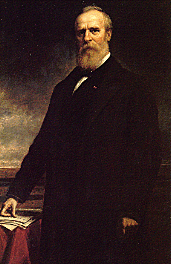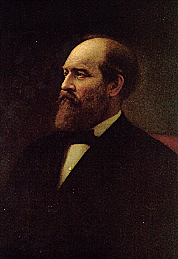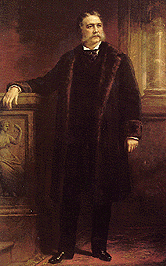Presidents 19-21


Rutherford B. Hayes

Republican party officials approached Rutherford Birchard Hayes while he was
serving as an officer in the Union army during the Civil War. The party
officials wanted Hayes to run for Congress. Hayes felt his duty was to his
unit and his country and he refused. The Republicans ran Hayes without his
permission. Though he won the election, the new member of Congress would not
leave the army until after the war was over.
Hayes was an honest and hard-working Ohio lawyer and politician. He entered
the Union army two months after the Civil War began, led a gallant charge at
the Battle of South Mountain, and was badly wounded in his left arm. By the
end of the war, he had been promoted to major general.
Hayes served in Congress after the war, and then became governor of Ohio. In
1876, the Republicans chose Hayes as their presidential candidate after the
convention could not agree on anyone else.
The Democratic candidate was Samuel Tilden. Like Hayes, Tilden had a
reputation for reform and honest government. The two candidates split the vote
nearly evenly and the crucial deciding electoral votes were disputed. Congress
established a commission to decide who had won. When it became clear that
Hayes would be declared the winner, the Democrats made a deal. The Democrats
would support the commission's decision if Hayes agreed to end Reconstruction
and withdraw the last federal troops from the South. After securing pledges
from prominent southerners that the rights of African Americans would be
respected, Hayes agreed.
The end of Reconstruction helped ease tensions between the North and the
South, but the promises made to Hayes proved hollow. African Americans living
in the South found themselves deprived of their political rights.
Hayes ran an honest government. He did his best to reform the civil service
and the spoils system. But Hayes tired of the presidency. He called it a
"life of bondage, responsibility, and toil." He did not seek a
second term.

James A. Garfield

James Abram Garfield was the last President to be born in a log cabin. But he
never romanticized the hardships of his childhood. "Let no man praise me
because I was poor," he once said. "It was . . . in every way bad
for my life."
Garfield was an Ohio college teacher and administrator who had turned to
politics to get ahead in life. He helped organize the 42nd Ohio Infantry
during the Civil War, fighting at the battles of Shiloh and Chickamauga.
Eventually, he became the youngest general in the Union army. Like President
Hayes, Garfield was elected to Congress while still serving in the army. And
like Hayes, Garfield thought his duty lay with the military. But after a
personal letter from President Lincoln, he agreed to take his seat in
Congress.
After the war, Garfield served in Congress for 17 years. The Republicans chose
him as their presidential candidate in 1880 when party leaders could not
decide between ex-President Grant and Senator James Blaine of Maine. Garfield
defeated Democrat Winfield Scott Hancock, with a majority of less than 7,500
popular votes.
Garfield's presidency lasted only 200 days. On July 2, 1881, the President was
shot in the back while passing though the Washington D.C. railroad station; he
died eleven weeks later. The assassin, Charles Guiteau, was a disappointed
office-seeker. As a result of the assassination, Congress passed the Civil
Service Reform Act in an attempt to do away with the spoils system which had
played a part in Guiteau's demented act of frustration.

Chester A. Arthur

The presidency has the power to change men, but few men have been as
transformed by the office as Chester Arthur. After a lifetime as a political
boss, Arthur began calling for political reform as soon as he became
President. His former political cronies could not believe their ears.
Chester Alan Arthur was born in Vermont, but he became a New York lawyer.
During the Civil War he joined the New York State militia and was eventually
promoted to quartermaster general. After the war, Arthur became a part of the
powerful New York Republican political machine and worked closely with the
party boss, Senator Roscoe Conkling. President Grant appointed Arthur
Collector for the Port of New York. There, Arthur continued the customhouse
practice of "creating" jobs and handing them out as rewards for
loyalty to Conkling. President Hayes, attempting to end corruption in the
civil service, fired Arthur.
Arthur was nominated as James Garfield's running mate at the Republican
Convention in 1880. Making him the vice presidential candidate was an attempt
to win the support of New York Senator Roscoe Conkling and his
"Stalwart" supporters. The Stalwarts were Republicans who opposed
governmental reform. Garfield and Arthur won the election. The vice presidency
was the first elected office Arthur had ever held. He did not hold it for
long.
When Garfield was assassinated by a man who cried "I am a Stalwart and
now Chester Arthur is President!" Arthur was horrified. It seemed as if
the corrupt spoils system had helped cause the assassination. The new
President decided to support reform even though it angered Conkling and many
Republican party bosses. In 1883, he signed the Pendleton Act, which created
the modern civil service. Under the new law, many federal positions would be
filled on the basis of competitive exams, rather than handed out as political
favors.
The Republican bosses did not renominate Arthur, and he retired to New York
City. He died on November 18, 1886, from Bright's Disease, a kidney ailment.

All images of Presidents are courtesy of whitehouse.gov
Information taken from Software titled "American Heritage The History of
the United States for Young People.
The copyright belongs to: Forbes
Inc. and Byron Preiss Multimedia Company. Thank You!

Washington, Adams, Jefferson
Madison, Monroe, Adams
Jackson, Van Buren, Harrison
Tyler, Polk, Taylor
Fillmore, Pierce, Buchanan
Lincoln, Johnson, Grant
Hayes, Garfield, Arthur
Cleveland, Harrison, Cleveland
McKinley, T. Roosevelt, Taft
Wilson, Harding, Coolidge
Hoover, F. Roosevelt, Truman
Eisenhower, Kennedy, Johnson
Nixon, Ford, Carter
Reagan, Bush, Clinton
Bush, ????, ????
|

|
All graphics and
pages are copyright © 1997 - 2008 Pages 4 Ever
(except where noted). Do not take, copy, steal, plagiarize or use in any
way, shape or format without the express written permission of Pages
4 Ever.
Some backgrounds and graphics made from clipart acquired from ArtToday, Boxed Art,
friends, my own imagination, and/or
graphic CD collections that I have purchased. If you find anything on this site
that you have copyright to, and can prove it, please let me know and I will
gladly either remove it or place a link back to you, whichever you prefer.
If you should find any broken links, please drop us a line and let us know the
exact URL the broken link is on. Thank you.
|

|
![]()





